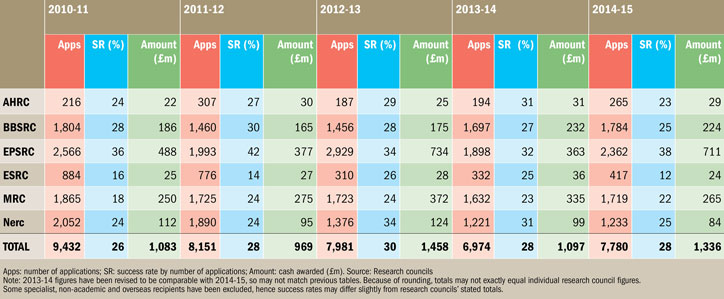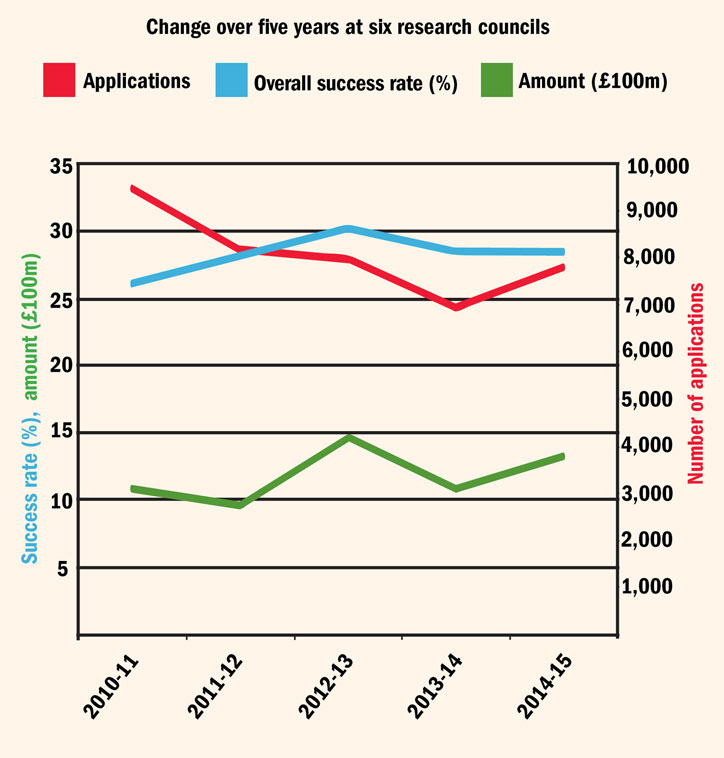The number of applications to the research councils has grown for the first time in at least six years as researchers “hustle for money” after the completion of the research excellence framework last year.
Councils are said to be “struggling” to find enough reviewers to review grant applications and are under further pressure to reduce administration costs as further cuts loom in the November spending review.
In 2014-15, there were 7,780 applications to research councils, according to calculations by Times Higher Education, a 12 per cent increase on the year before despite efforts to deter weaker bids.
Success rates fell at five out of six councils, halving in the case of the Economic and Social Research Council to just 12 per cent (the Science and Technology Facilities Council was excluded from the analysis).
The overall success rate dropped by half a percentage point to just under 28 per cent, and would have fallen much further had it not been for an “abnormally” high level of funding in 2014-15 at the Engineering and Physical Sciences Research Council, where success rates shot up.
According to Ben Martin, professor of science and technology policy studies at the University of Sussex, the surge in applications could be due to the fact that prior to the 2014 REF, researchers focused on getting their results published.
Success rates by research council
Now the exercise is over, scholars are once again trying to “hustle for money”, he said. “I suspect this year and next year they [applications] may be up, after that the emphasis may switch to writing up.”
Like journals, the research councils “are struggling” to find enough reviewers, Professor Martin continued. “It certainly does put pressure on them."
A further sizeable increase in applications would lead to a fall in overall success rates, which would be “unhealthy” for the councils and researchers alike, he added.
Once success rates drop below 20 per cent, the process “becomes more of a lottery” as reviewers are more stretched, and it becomes more “demoralising” and even inefficient for researchers to bid for grants, Professor Martin explained.
A 2006 report by the research councils warned that success rates of below 20 per cent create “unacceptable inefficiencies” in the process.
At the EPSRC, success rates were actually up, from 32 to 38 per cent. But a spokesman for the council said that the amount of money distributed in 2014-15 (£711 million, more than half of the overall total) had been “abnormally high” as it included grants for quantum technologies and major capital projects.
Trends over time
Applications to the Arts and Humanities Research Council grew by more than a third. The number of grants held steady, causing a drop in success rates to 23 per cent.
A spokeswoman for the council said that the increase was in the “normal variation range” and could be due to the type of calls that were open during the year, when applicants were ready to submit applications and the number of other funding opportunities available.
At the Medical Research Council, applications were up 5 per cent. The number of grants grew almost in proportion, meaning that success rates dipped only slightly to 22 per cent. Yet funding fell significantly, meaning that the average grant size fell by nearly a quarter.
Sarah Collinge, head of research funding operations, said that the MRC had not “preferentially funded lower value awards or reduced the value of individual awards made, except on scientific grounds”.
“The success rate by number and value are almost the same in 2014-15 unlike the previous year when the success rate by value was skewed by a few very large awards that included capital,” she explained.
POSTSCRIPT:
Print headline: Success rates tumble amid surge in grant applications
Register to continue
Why register?
- Registration is free and only takes a moment
- Once registered, you can read 3 articles a month
- Sign up for our newsletter
Subscribe
Or subscribe for unlimited access to:
- Unlimited access to news, views, insights & reviews
- Digital editions
- Digital access to THE’s university and college rankings analysis
Already registered or a current subscriber? Login









